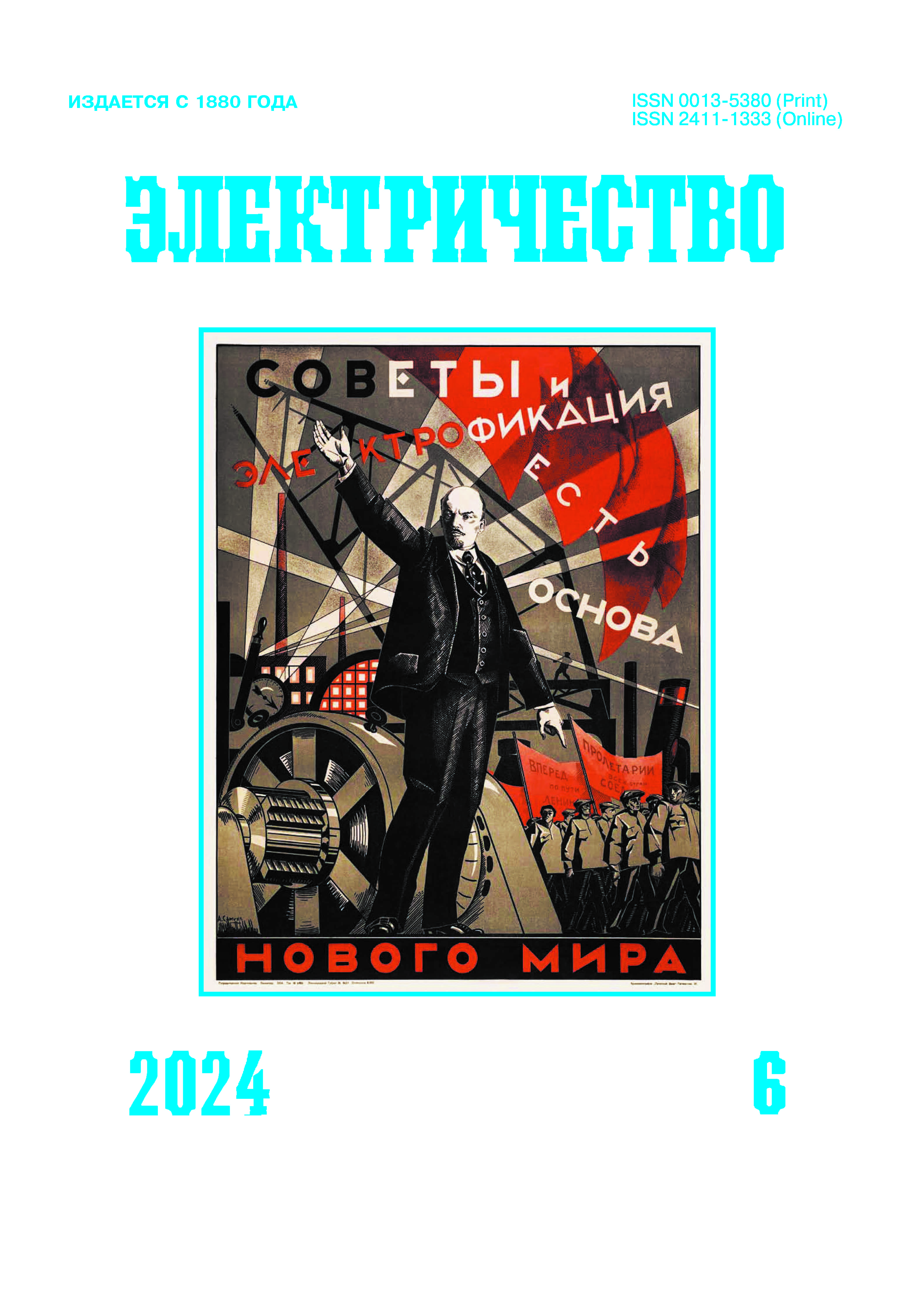A Mathematical Model of a Reactive Two-Pole Electric Machine with Anisotropic Permeance of the Rotor
DOI:
https://doi.org/10.24160/0013-5380-2024-6-73-81Keywords:
mathematical model, equivalent circuit diagram, anisotropy coefficient, magnetic leakage coefficient, magnetic asymmetry coefficientAbstract
A mathematical model of a reactive electrical machine with anisotropic permeance of the rotor is discussed. Calculations of the power performance characteristics for this electrical machine, a description of the magnetic field of a two-pole machine with anisotropic permeance of the rotor, and a mathematical description of its permeances are presented. Analytical relations for determining the magnetic field direct and quadrature components are obtained based on the machine magnetic circuit equivalent circuit diagram. The introduced magnetic asymmetry coefficient is an indicator from which the influence of fastening recesses, as well as the rotor inter-pole air gap on the machine characteristics is estimated. The graphic dependence of the magnetic asymmetry coefficient on the rotor pole overlap coefficient with the anisotropy equal to unity demonstrates the effect these parameters have on the quality and power performance characteristics of a reactive electrical machine with anisotropic permeance of the rotor. A conclusion has been drawn from the data presented that an increase in the magnetic asymmetry coefficient results in that the sinusoidal distribution of magnetic induction becomes distorted, and that higher harmonic components appear in the pulsations of the stator phase winding inductances, and as a consequence, pulsations appear in the machine electromagnetic torque.
References
2. Самосейко В.Ф., Гельвер Ф.А. Сравнение различных типов реактивных электрических машин по энергетическим показателям. – Труды Крыловского государственного научного центра, 2015, № 89 (373), с. 201–208.
3. Гельвер Ф.А., Белоусов И.В., Самосейко В.Ф. Результаты экспериментальных исследований опытного образца реактивной электрической машины с анизотропной магнитной проводимостью ротора. – Вестник ПНИПУ. Электротехника, информационные технологии, системы управления, 2019, № 29, с. 148–173.
4. Вольдек А.И. Электрические машины. Л.: Энергия, 1978, 832 с.
5. Saxena R. et al. Performance Analysis of Axially Laminated Anisotropic Synchronous Reluctance Motor. – 7th WSEAS International Conference on Electric Power Systems, High Voltages, Electric Machine, 2007, pp. 97–102.
6. Kolehmainen J. Synchronous Reluctance Motor with Form Blocked Rotor. – IEEE Transactions on Energy Conversion, 2010, vol. 25 (2), pp. 450–456, DOI: 10.1109/TEC.2009.2038579.
7. Oprea C., Dziechciarz A, Martis C. Comparative Analysis of Different Synchronous Reluctance Motor Topologies. – International Conference on Environment and Electrical Engineering, 2015, DOI: 10.1109/EEEIC.2015.7165463.
8. Tahi S., Ibtiouen R., Bounekhla M. Design Optimization of Two Synchronous Reluctance Machine Structures with Maximized Torque and Power Factor. – Progress In Electromagnetics Research B, 2011, vol. 35, pp. 369–387, DOI: 10.2528/PIERB11091101.
9. Bianchi N. et al. Rotor Flux-Barrier Design for Torque Ripple Reduction in Synchronous Reluctance and PM-Assisted Synchronous Reluctance Motors. – IEEE Transactions on Industry Application, 2009, 45(3), pp. 921–928, DOI: 10.1109/TIA.2009.2018960.
10. Lee J.H. et al. Characteristics Analysis and Optimum Design of Anisotropy Rotor Synchronous Reluctance Motor Using Coupled Finite Element Method and Response Surface Methodology. – IEEE Transactions on Magnetics, 2009, vol. 45 (10), pp. 4696–4699, DOI: 10.1109/TMAG.2009.2024877.
11. Azizi H., Vahedi A. Rotor Geometry Parameter Optimization of Synchronous Reluctance Motor Using Taguchi Method. – Przegląd Elektrotechniczny, 2013, pp. 197–201.
12. Kim K.-C. et al. A Study on the Optimal Design of SynRM for the High Torque and Power Factor. – IEEE Transactions on Magnetics, 2007, 43 (6), pp. 2543–2545, DOI: 10.1109/TMAG.2007.893302.
13. Moghaddam R.R. Theoretical and Experimental Reevaluation of Synchronous Reluctance Machine / R. R. Moghaddam, F. Magnussen, Ch. Sadarangani. – IEEE Transactions on Industrial Electronics, 2010, vol. 57 (1), pp. 6–13, DOI: 10.1109/TIE.2009.2025286.
14. Самосейко В.Ф. Теоретические основы управления электроприводом. СПб.: Элмор, 2007, 464 c.
15. Копылов И.П. Проектирование электрических машин. M.: Юрайт, 2023, 828 с.
#
1. Gasanova L.G., Mustafaev R.I. Elektrichestvo – in Russ. (Electricity), 2019, № 3, с. 46–54.
2. Samoseyko V.F., Gel'ver F.А. Trudy Krylovskogo gosudarstvennogo nauchnogo tsentra – in Russ. (Proceedings of the Krylov State Scientific Center), 2015, No. 89 (373), pp. 201–208.
3. Gel'ver F.A., Belousov I.V., Samoseyko V.F. Vestnik PNIPU. Elektrotekhnika, informatsionnye tekhnologii, sistemy upravleniya – in Russ. (Bulletin of PNRPU. Electrical engineering, information technology, control systems), 2019, No. 29, pp. 148–173.
4. Vol'dek A.I. Elektricheskie mashiny (Electric Machines). L.: Energiya, 1978, 832 p.
5. Saxena R. et al. Performance Analysis of Axially Laminated Anisotropic Synchronous Reluctance Motor. – 7th WSEAS International Conference on Electric Power Systems, High Voltages, Electric Machine, 2007, pp. 97–102.
6. Kolehmainen J. Synchronous Reluctance Motor with Form Blocked Rotor. – IEEE Transactions on Energy Conversion, 2010, vol. 25 (2), pp. 450–456, DOI: 10.1109/TEC.2009.2038579.
7. Oprea C., Dziechciarz A, Martis C. Comparative Analysis of Different Synchronous Reluctance Motor Topologies. – International Conference on Environment and Electrical Engineering, 2015, DOI: 10.1109/EEEIC.2015.7165463.
8. Tahi S., Ibtiouen R., Bounekhla M. Design Optimization of Two Synchronous Reluctance Machine Structures with Maximized Torque and Power Factor. – Progress In Electromagnetics Research B, 2011, vol. 35, pp. 369–387, DOI: 10.2528/PIERB11091101.
9. Bianchi N. et al. Rotor Flux-Barrier Design for Torque Ripple Reduction in Synchronous Reluctance and PM-Assisted Synchronous Reluctance Motors. – IEEE Transactions on Industry Application, 2009, 45(3), pp. 921–928, DOI: 10.1109/TIA.2009.2018960.
10. Lee J.H. et al. Characteristics Analysis and Optimum Design of Anisotropy Rotor Synchronous Reluctance Motor Using Coupled Finite Element Method and Response Surface Methodology. – IEEE Transactions on Magnetics, 2009, vol. 45 (10), pp. 4696–4699, DOI: 10.1109/TMAG.2009.2024877.
11. Azizi H., Vahedi A. Rotor Geometry Parameter Optimization of Synchronous Reluctance Motor Using Taguchi Method. – Przegląd Elektrotechniczny, 2013, pp. 197–201.
12. Kim K.-C. et al. A Study on the Optimal Design of SynRM for the High Torque and Power Factor. – IEEE Transactions on Magnetics, 2007, 43 (6), pp. 2543–2545, DOI: 10.1109/TMAG.2007.893302.
13. Moghaddam R.R. Theoretical and Experimental Reevaluation of Synchronous Reluctance Machine / R. R. Moghaddam, F. Magnussen, Ch. Sadarangani. – IEEE Transactions on Industrial Electronics, 2010, vol. 57 (1), pp. 6–13, DOI: 10.1109/TIE.2009.2025286.
14. Samoseyko V.F. Teoreticheskie osnovy upravleniya elektro-privodom (Theoretical Foundations of Electric Drive Control). SPb.: Elmor, 2007, 464 p.
15. Kopylov I.P. Proektirovanie elektricheskih mashin (Design of Electric Machines). M.: Yurayt, 2023, 828 p




